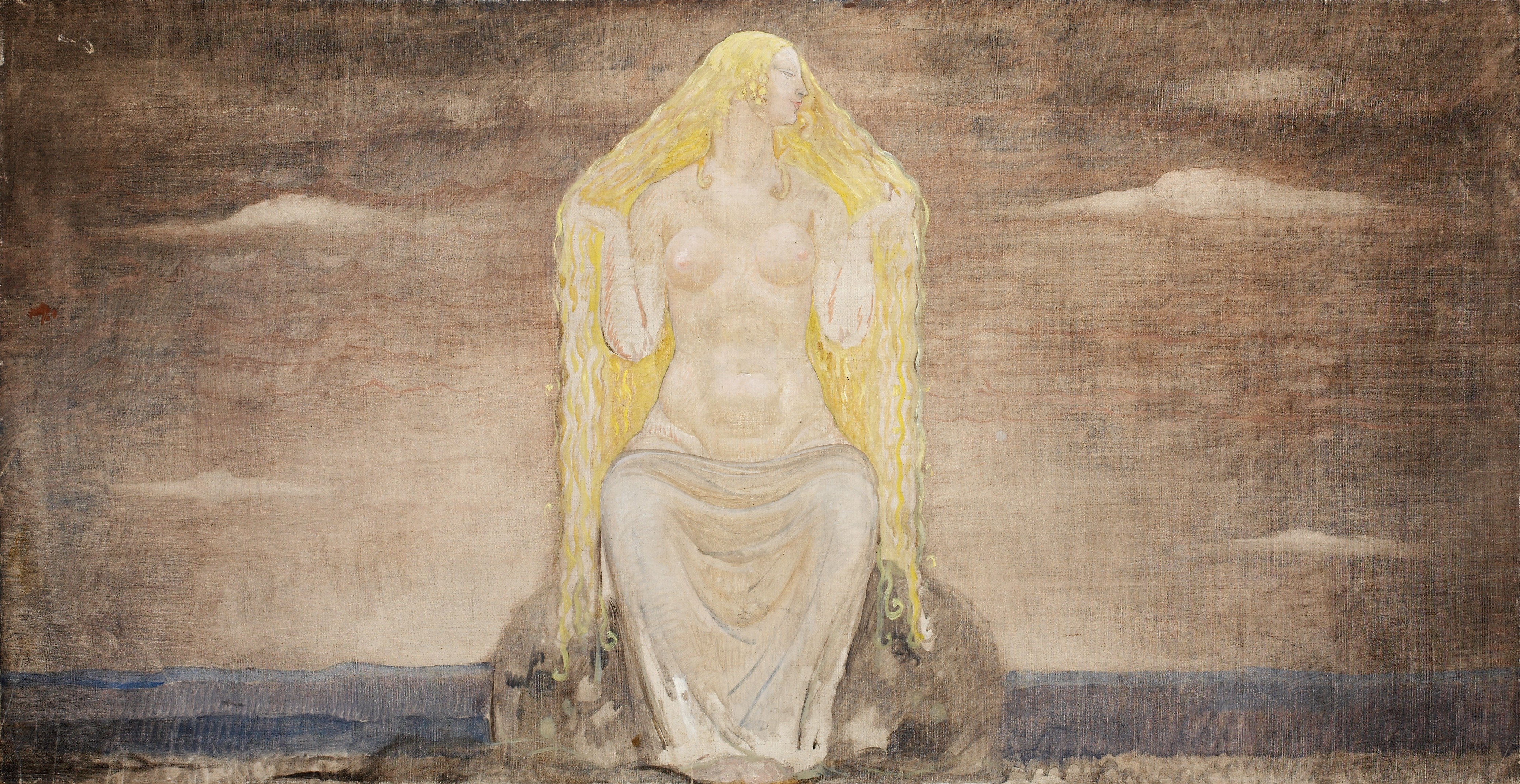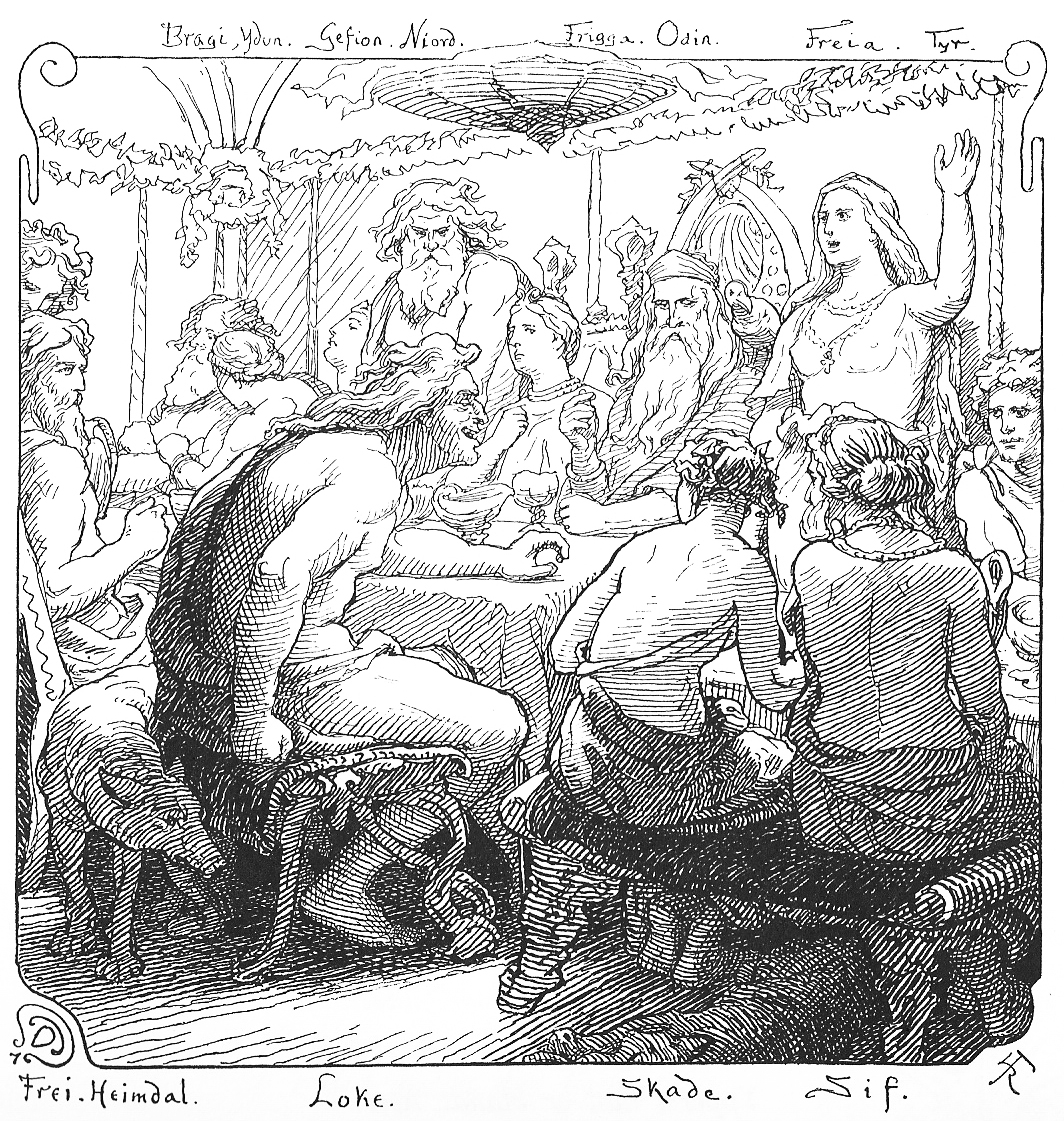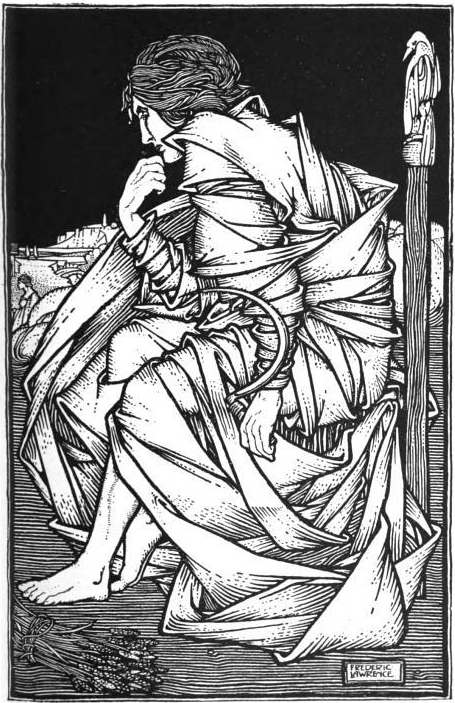|
Vanir
In Norse mythology, the Vanir (; Old Norse: , singular Vanr ) are a group of gods associated with fertility, wisdom, and the ability to see the future. The Vanir are one of two groups of gods (the other being the Æsir) and are the namesake of the location Vanaheimr (Old Norse "Home of the Vanir"). After the Æsir–Vanir War, the Vanir became a subgroup of the Æsir. Subsequently, members of the Vanir are sometimes also referred to as members of the Æsir. The Vanir are attested in the ''Poetic Edda'', compiled in the 13th century from earlier traditional sources; the ''Prose Edda'' and ''Heimskringla'', both written in the 13th century by Snorri Sturluson; and in the poetry of skalds. The Vanir are only attested in these Old Norse sources. All sources describe the god Njörðr, and his children Freyr and Freyja as members of the Vanir. A euhemerized prose account in ''Heimskringla'' adds that Njörðr's sister—whose name is not provided—and Kvasir were Vanir. In addition, ' ... [...More Info...] [...Related Items...] OR: [Wikipedia] [Google] [Baidu] |
Æsir–Vanir War
In Norse mythology, the Æsir–Vanir War was a conflict between two groups of deities that ultimately resulted in the unification of the Æsir and the Vanir into a single pantheon. The war is an important event in Norse mythology, and the implications for the potential historicity surrounding accounts of the war are a matter of scholarly debate and discourse. Fragmented information about the war appears in surviving sources, including ''Völuspá'', a poem collected in the ''Poetic Edda'' in the 13th century from earlier traditional sources; in the book ''Skáldskaparmál'' in the ''Prose Edda'', written or compiled in the 13th century by Snorri Sturluson; and in euhemerized form in the ''Ynglinga saga'' from ''Heimskringla'', also often considered to have been written by Snorri Sturluson in the 13th century. Attestations ''Poetic Edda'' In two stanzas of ''Völuspá'', the war is recounted by a völva (who refers to herself here in the third person) while the god Óðinn qu ... [...More Info...] [...Related Items...] OR: [Wikipedia] [Google] [Baidu] |
Æsir
The Æsir (Old Norse: ) are the gods of the principal pantheon in Norse religion. They include Odin, Frigg, Höðr, Thor, and Baldr. The second Norse pantheon is the Vanir. In Norse mythology, the two pantheons wage war against each other, resulting in a unified pantheon. Unlike the Old English word ''god'' (and the Old Norse word '), Æsir was never converted over to Christian use. Etymology ''Æsir'' is the plural of '' áss'', ''ǫ́ss'' "god". In genitival compounds, it takes the form ', e.g. in ' ("Thor of the Æsir"), besides ' found in : '' ás-brú'' "gods' bridge" (the rainbow), : ' "gods' enclosure", : ' "gods' kin", : ' "gods' leader", : ' "gods' might" (especially of Thor), : ' "divine wrath" etc. : ' "national god" (') is a title of Thor, as is : ' "almighty god", while it is Odin who is "the" '. There is also Old East Norse dialectal : *''ās-ækia'' (OWN: *''áss-ekja''), i.e. "god ride" (Thor riding in his wagon), resulting in the modern Swedish word ... [...More Info...] [...Related Items...] OR: [Wikipedia] [Google] [Baidu] |
Freyja
In Norse paganism, Freyja ( Old Norse "(the) Lady") is a goddess associated with love, beauty, fertility, sex, war, gold, and seiðr (magic for seeing and influencing the future). Freyja is the owner of the necklace Brísingamen, rides a chariot pulled by two cats, is accompanied by the boar Hildisvíni, and possesses a cloak of falcon feathers. By her husband Óðr, she is the mother of two daughters, Hnoss and Gersemi. Along with her twin brother Freyr, her father Njörðr, and her mother ( Njörðr's sister, unnamed in sources), she is a member of the Vanir. Stemming from Old Norse ''Freyja'', modern forms of the name include Freya, Freyia, and Freja. Freyja rules over her heavenly field, Fólkvangr, where she receives half of those who die in battle. The other half go to the god Odin's hall, Valhalla. Within Fólkvangr lies her hall, Sessrúmnir. Freyja assists other deities by allowing them to use her feathered cloak, is invoked in matters of fertility and love, ... [...More Info...] [...Related Items...] OR: [Wikipedia] [Google] [Baidu] |
Vanaheimr
In Norse cosmology, Vanaheimr (Old Norse for 'home of the Vanir'Byock (2005:158).) is a location associated with the Vanir, a group of gods themselves associated with fertility, wisdom, and the ability to see the future. Vanaheimr is attested in the '' Poetic Edda''; compiled in the 13th century from earlier traditional sources, and the '' Prose Edda'' and (in euhemerized form) ''Heimskringla''; both written in the 13th century by Snorri Sturluson. In the ''Poetic Edda'' and the ''Prose Edda'', Vanaheimr is described as the location where the god Njörðr was raised. Attestations Vanaheimr is mentioned a single time in the ''Poetic Edda''; in a stanza of the poem '' Vafþrúðnismál''. In ''Vafþrúðnismál'', Gagnráðr (the god Odin in disguise) engages in a game of wits with the jötunn Vafþrúðnir. Gagnráðr asks Vafþrúðnir whence the Van god Njörðr came, for, though he rules over many hofs and hörgrs, Njörðr was not raised among the Æsir. Vafþrúðni ... [...More Info...] [...Related Items...] OR: [Wikipedia] [Google] [Baidu] |
Njörðr
In Norse mythology, Njörðr (Old Norse: ) is a god among the Vanir. Njörðr, father of the deities Freyr and Freyja by his unnamed sister, was in an ill-fated marriage with the goddess Skaði, lives in Nóatún and is associated with the sea, seafaring, wind, fishing, wealth, and crop fertility. Njörðr is attested in the ''Poetic Edda'', compiled in the 13th century from earlier traditional sources, the ''Prose Edda'', written in the 13th century by Snorri Sturluson, in euhemerized form as a beloved mythological early king of Sweden in ''Heimskringla'', also written by Snorri Sturluson in the 13th century, as one of three gods invoked in the 14th century ''Hauksbók'' ring oath, and in numerous Scandinavian place names. Veneration of Njörðr survived into the 18th or 19th century Norwegian folk practice, where the god is recorded as Njor and thanked for a bountiful catch of fish. Njörðr has been the subject of an amount of scholarly discourse and theory, often conne ... [...More Info...] [...Related Items...] OR: [Wikipedia] [Google] [Baidu] |
Freyr
Freyr (Old Norse: 'Lord'), sometimes anglicized as Frey, is a widely attested god in Norse mythology, associated with kingship, fertility, peace, and weather. Freyr, sometimes referred to as Yngvi-Freyr, was especially associated with Sweden and seen as an ancestor of the Swedish royal house. According to Adam of Bremen, Freyr was associated with peace and pleasure, and was represented with a phallic statue in the Temple at Uppsala. According to Snorri Sturluson, Freyr was "the most renowned of the æsir", and was venerated for good harvest and peace. In the mythological stories in the Icelandic books the ''Poetic Edda'' and the '' Prose Edda'', Freyr is presented as one of the Vanir, the son of the god Njörðr and his sister-wife, as well as the twin brother of the goddess Freyja. The gods gave him Álfheimr, the realm of the Elves, as a teething present. He rides the shining dwarf-made boar Gullinbursti and possesses the ship Skíðblaðnir which always has a favorab ... [...More Info...] [...Related Items...] OR: [Wikipedia] [Google] [Baidu] |
Kvasir
In Norse mythology, Kvasir (Old Norse: ) was a being born of the saliva of the Æsir and the Vanir, two groups of gods. Extremely wise, Kvasir traveled far and wide, teaching and spreading knowledge. This continued until the dwarfs Fjalar and Galar killed Kvasir and drained him of his blood. The two mixed his blood with honey, thus creating the Mead of Poetry, a mead which imbued the drinker with skaldship and wisdom, and the spread of which eventually resulted in the introduction of poetry to mankind. Kvasir is attested in the '' Prose Edda'' and '' Heimskringla'', both written by Snorri Sturluson in the 13th century, and in the poetry of skalds. According to the ''Prose Edda'', Kvasir was instrumental in the capture and binding of Loki, and an euhemerized account of the god appears in ''Heimskringla'', where he is attested as the wisest among the Vanir. Scholars have connected Kvasir to methods of beverage production and peacemaking practices among ancient peoples. Attesta ... [...More Info...] [...Related Items...] OR: [Wikipedia] [Google] [Baidu] |
Ullr
In Norse mythology, Ullr (Old Norse: ) is a god associated with archery. Although literary attestations of Ullr are sparse, evidence including relatively ancient place-name evidence from Scandinavia suggests that he was a major god in earlier Germanic paganism. Proto-Germanic *''wulþuz'' (' glory') appears to have been an important concept of which his name is a reflex. The word appears as ''owlþu-'' on the 3rd-century Thorsberg chape. Name and origin The Old Norse theonym ''Ullr'' derives from a Proto-Germanic (PGmc) form reconstructed as ''*Wulþuz'' ('Glory'), which is attested in the compound ''owlþu-þewaz'' (ᛟᚹᛚᚦᚢᚦᛖᚹᚨᛉ), meaning either 'servant of ''Owlþuz''' (if interpreted as a theonym), or 'who has glorious servants' (if interpreted as an adjective), found on the Thorsberg chape (3rd c. AD). It is a cognate (linguistic sibling from the same origin) of the Gothic noun ''wulþus'' ('glory, wealth'). They ultimately derive from the Proto-Indo-E ... [...More Info...] [...Related Items...] OR: [Wikipedia] [Google] [Baidu] |
Heimdallr
In Norse mythology, Heimdall (from Old Norse Heimdallr) is a god who keeps watch for invaders and the onset of Ragnarök from his dwelling Himinbjörg, where the burning rainbow bridge Bifröst meets the sky. He is attested as possessing foreknowledge and keen senses, particularly eyesight and hearing. The god and his possessions are described in enigmatic manners. For example, Heimdall is gold-toothed, "the head is called his sword," and he is "the whitest of the gods." Heimdall possesses the resounding horn Gjallarhorn and the golden-maned horse Gulltoppr, along with a store of mead at his dwelling. He is the son of Nine Mothers, and he is said to be the originator of social classes among humanity. Other notable stories include the recovery of Freyja's treasured possession Brísingamen while doing battle in the shape of a seal with Loki. The antagonistic relationship between Heimdall and Loki is notable, as they are foretold to kill one another during the events of Ragn ... [...More Info...] [...Related Items...] OR: [Wikipedia] [Google] [Baidu] |
Norse Mythology
Norse, Nordic, or Scandinavian mythology is the body of myths belonging to the North Germanic peoples, stemming from Old Norse religion and continuing after the Christianization of Scandinavia, and into the Nordic folklore of the modern period. The northernmost extension of Germanic mythology and stemming from Proto-Germanic folklore, Norse mythology consists of tales of various deities, beings, and heroes derived from numerous sources from both before and after the pagan period, including medieval manuscripts, archaeological representations, and folk tradition. The source texts mention numerous gods such as the thunder-god Thor, the raven-flanked god Odin, the goddess Freyja, and numerous other deities. Most of the surviving mythology centers on the plights of the gods and their interaction with several other beings, such as humanity and the jötnar, beings who may be friends, lovers, foes, or family members of the gods. The cosmos in Norse mythology consists of Nine ... [...More Info...] [...Related Items...] OR: [Wikipedia] [Google] [Baidu] |
Sister-wife Of Njörðr
In Norse mythology, the sister-wife of Njörðr is the unnamed wife and sister of the god Njörðr, with whom he is described as having had the (likewise incestuous) twin children Freyr and Freyja. This shadowy goddess is attested in the '' Poetic Edda'' poem '' Lokasenna'', recorded in the 13th century by an unknown source, and the ''Heimskringla'' book ''Ynglinga saga'', a euhemerized account of the Norse gods composed by Snorri Sturluson also in the 13th century but based on earlier traditional material. The figure receives no further mention in Old Norse texts. The situation is further complicated in that narratives describing the birth of Freyr and Freyja contradictorily cite the birth of the siblings occurring either after or before Njörðr left Vanaheimr to live among the Æsir. In addition, Freyr is referred to as the "son" of Njörðr and the goddess Skaði in the ''Poetic Edda'' poem ''Skírnismál''. In his first-century work ''Germania'', Tacitus describes rituals ... [...More Info...] [...Related Items...] OR: [Wikipedia] [Google] [Baidu] |


_The_Cosmos_in_the_Norse_mythology.jpg)




